Books
Floral Designer Lindsey Taylor on Finding Inspiration in Art and Nature
A new book released by Phaidon is based on Taylor's popular Wall Street Journal column, Flower School.
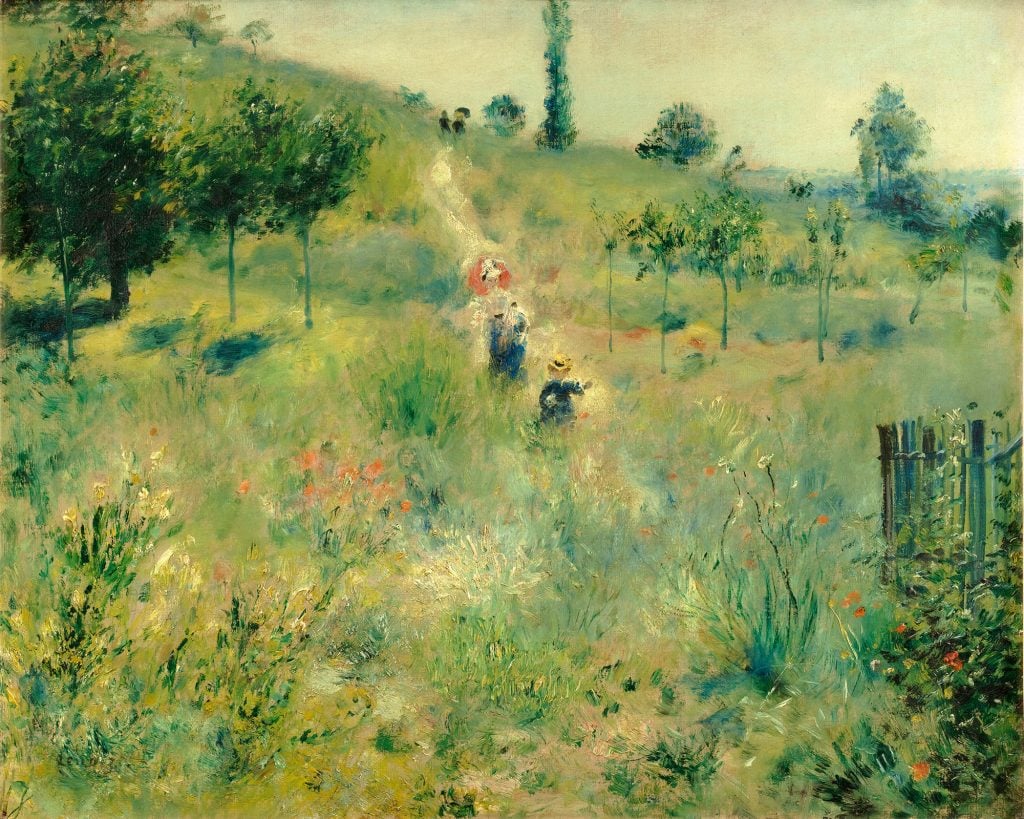
A new book released by Phaidon is based on Taylor's popular Wall Street Journal column, Flower School.

Lindsey Taylor

The following is excerpted from Art in Flower: Finding Inspiration in Art and Nature by Lindsey Taylor (© 2023), with a foreword by Deborah Needleman (released in the U.S. November 2023). Reproduced by permission of Monacelli, a Phaidon company. All rights reserved.
Seasons have a way of yielding to the next just when I seem to need it. Some people like to hold on to summer and lament the coming of fall and winter. I’m not that person. I’m always ready for the change, and winter may be the most welcome after a busy growing season. Solitude and a sense of repose permeate, and a blanket of snow covering the landscape and garden that have performed to their fullest is a relaxing sight.
Since I know it won’t last, that spring will come again, winter offers its own beauty. I embrace it. On a sunny winter day, the light can be so clear and sparkly, crisply illuminating the world. On a gray day, the lines of trees against the sky are like nature’s pencil drawings. Deciduous oaks, beeches, hornbeams, and some witch hazel do their best to hold on to their crunchy, taupe-y leaves, withering while still on the stem (a phenomenon called marcescence), providing an earthy tone against all the neutrals.
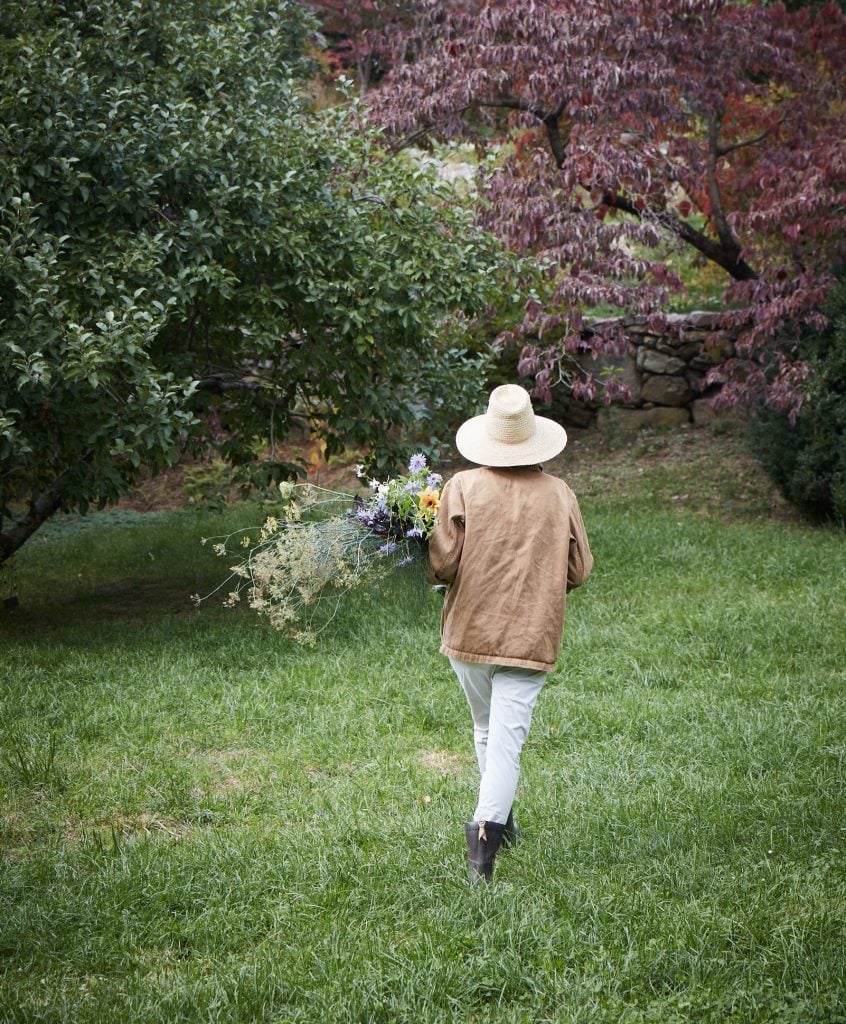
Lindsey Taylor, author of Art in Flower: Finding Inspiration in Art and Nature, gathering her materials. Photo: Ngoc Minh Ngo.
Hopefully, if you have a garden or a collection of potted plants, all the spring bulbs are in the ground, tucked in waiting to delight you in the months ahead. This foreknowledge is something to savor. Winter can also be a time to reflect and recharge. For me, it’s a time to make lists of plants I might want to add, to learn more about my natural environment, even to sign up for a ceramics class to make my own vessels.
My arrangements are more monochromatic this time of year: browns, blackened seed heads that poke up through the snow, dark shades of green from the broadleaf shrubs and needled conifers, making up an edited palette to work into the vessels. I’m happy with the more somber shades. A winter walk might have me cutting some interesting branches or discovering a native witch hazel or hellebore in bloom to add some pop. If I’m craving a hit of stronger color, especially around the holidays, I might pick up an amaryllis flower stem or collection of flowers in various shades of red at the local floral shop, giving the house a boost. Mostly, though, I’m nurturing houseplants and happy with the sculptural beauty of arrangements made up of mostly dead and woody things.
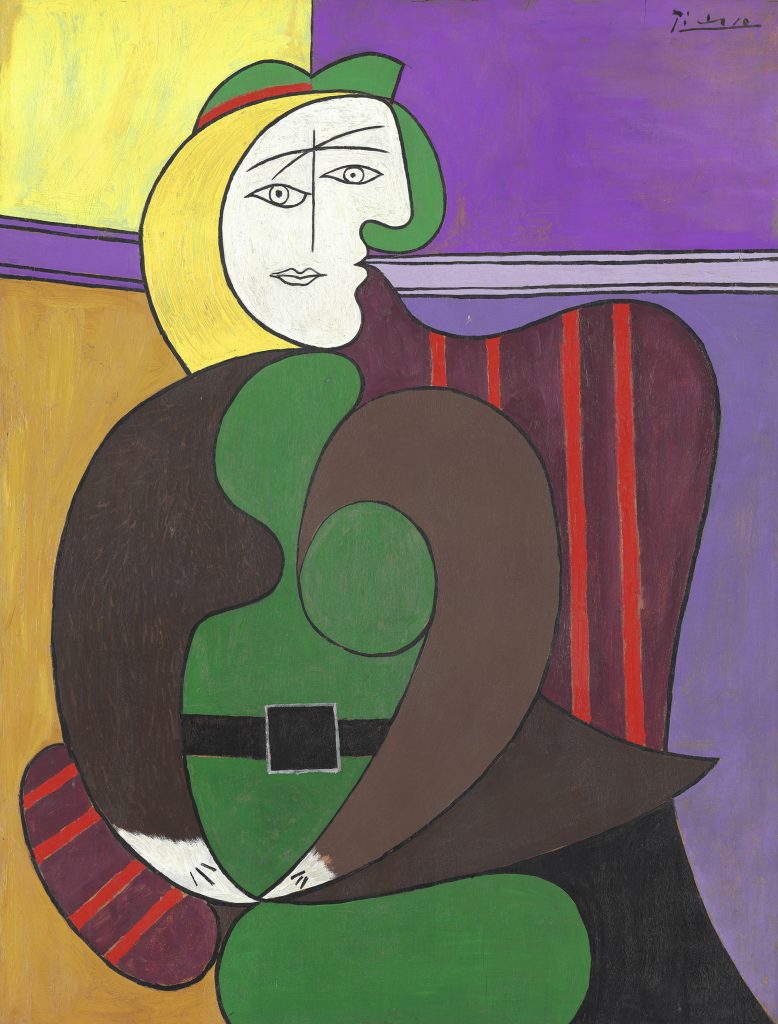
Pablo Picasso, The Red Armchair (1931), oil and Ripolin on panel. The Art Institute of Chicago/Art Resource, New York © ARS, New York.
On the East Coast, the year’s early months can be gloomy. During these hibernating days, the frozen garden offers little color to cut and bring indoors. Instead, for inspiration, I sought out something vivid, playful, and mood-elevating. A number of factors conspired to lead me to The Red Armchair, a painting by Pablo Picasso (1881–1973). One was an exhibit of his sculptures at New York’s Museum of Modern Art. I’d also come across a white earthenware vessel, known as the Medusa vase, by ceramist Frances Palmer. The wriggly stripes she’d pinched into the clay and the looping handles recalled Picasso’s work in general and specifically the face in this painting, a canvas that portrayed the banishing of winter listlessness. Vessels are important. They offer as much joy empty as full. Different styles serve different functions: straight-sided shapes give flowers a vertical modern rigor; a form that nips and flares, like an ironstone pitcher, lets blooms fall horizontally for a looser, romantic look.
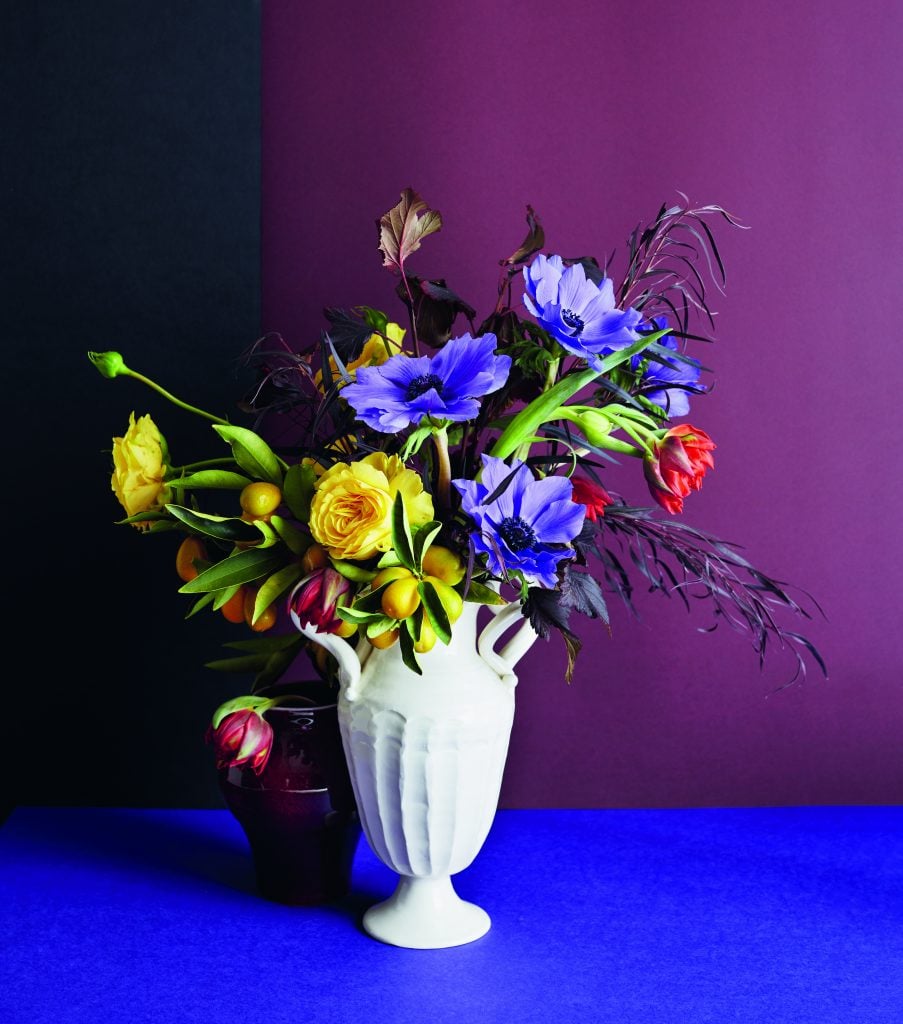
Anemones, kumquats, nandina foliage, ninebark, roses, and tulips, arranged by Lindsey Taylor. From Art in Flower: Finding Inspiration in Art and Nature, published by Monacelli, a Phaidon company. Photo: Stephen Kent Johnson.
From the flower market and a local deli, I sourced a bold mix of purple anemones, yellow roses, red parrot tulips, orange kumquat cuttings with green leaves, deep plum ninebark, and nandina foliage. I then grouped hues to reference the canvas’s color blocking. The yellows and oranges on the painting’s left were supplied by roses and kumquats. Anemones and ninebark evoke the upper right quadrant, and red tulips mimic the stripes. To give depth to the floral tableau, I tucked another of Ms. Palmer’s vases, porcelain in sang de boeuf glaze, to the left and let a single red tulip drape over the rim. This spirited mix of colors—some from blooms, some from citrus—successfully dispelled even the most ferocious late winter cabin fever.
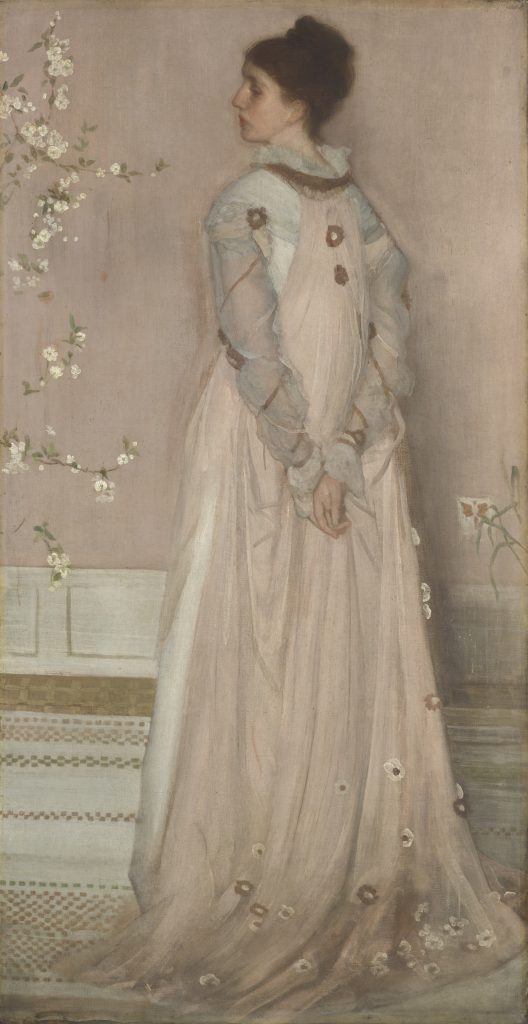
James McNeill Whistler, Symphony in Flesh Colour and Pink: Portrait of Mrs. Frances Leyland (1871–74), oil on canvas. Bequest of Henry Clay Frick, The Frick Collection, New York.
Mid-January is a time to slow down and look inward. This thought put me in mind of a calming, nearly monochromatic portrait by American artist James McNeill Whistler (1834–1903) in New York’s Frick Collection. In its subtlety and limited palette, it’s a reminder that less is often more—a fitting challenge for a flower arrangement, too.
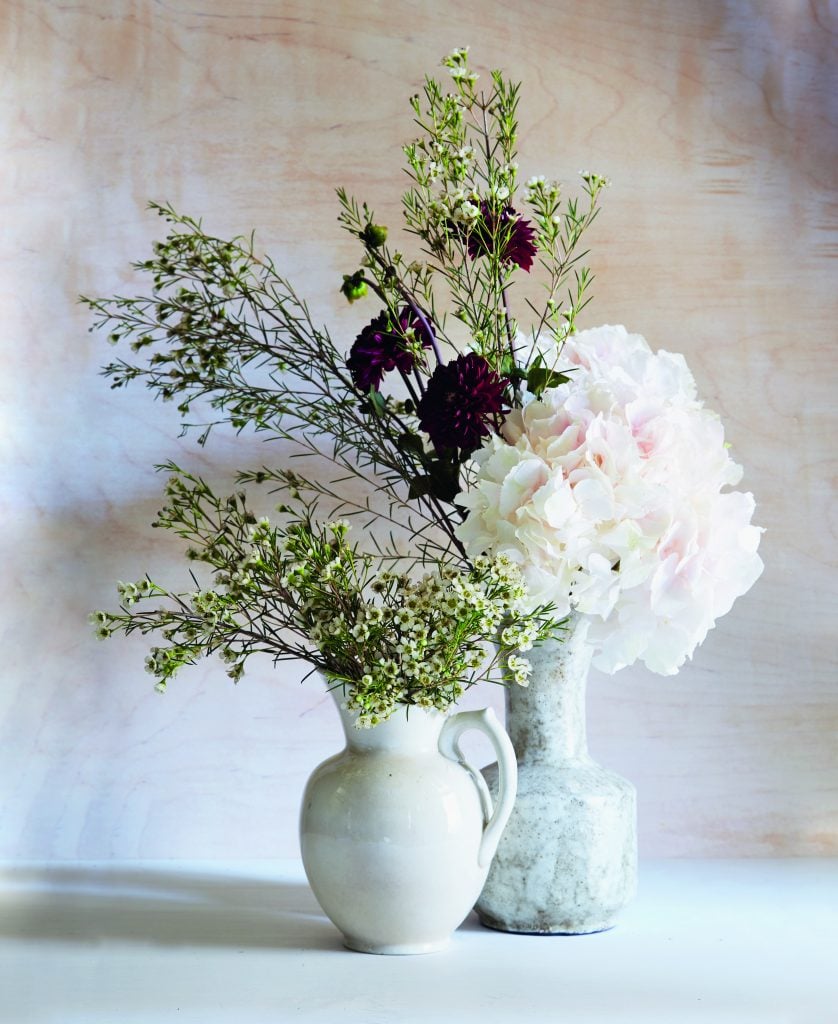
Dahlias, hydrangea, and waxflower, arranged by Lindsey Taylor. From Art in Flower: Finding Inspiration in Art and Nature, published by Monacelli, a Phaidon company. Photo: Stephen Kent Johnson.
To capture the canvas’s mood, I kept my blooms and vase selections soft and creamy. Using two vessels—an ironstone pitcher and a vintage vase—let me play with depth and the heights of the flowers. I cut short a white hydrangea, with a hint of blush pink, to hug and spill over the rim of the vase. Its tissue-like texture echoed the diaphanous fabric of the woman’s dress (one Whistler himself designed). Australian waxflower, with its willowy stems and tiny white flowers, alluded to the branches on the canvas’s left side and the lines on the dress’s sleeves. Dark maroon dahlias punctuated the arrangement, echoing the subject’s hair and the flowers on her dress—the only real tonal shifts in the painting. My goal was to be as true as possible to the dreamy effect of this quietly striking canvas, where the figure and the room in which she stands seem to blend in a harmonious whole.
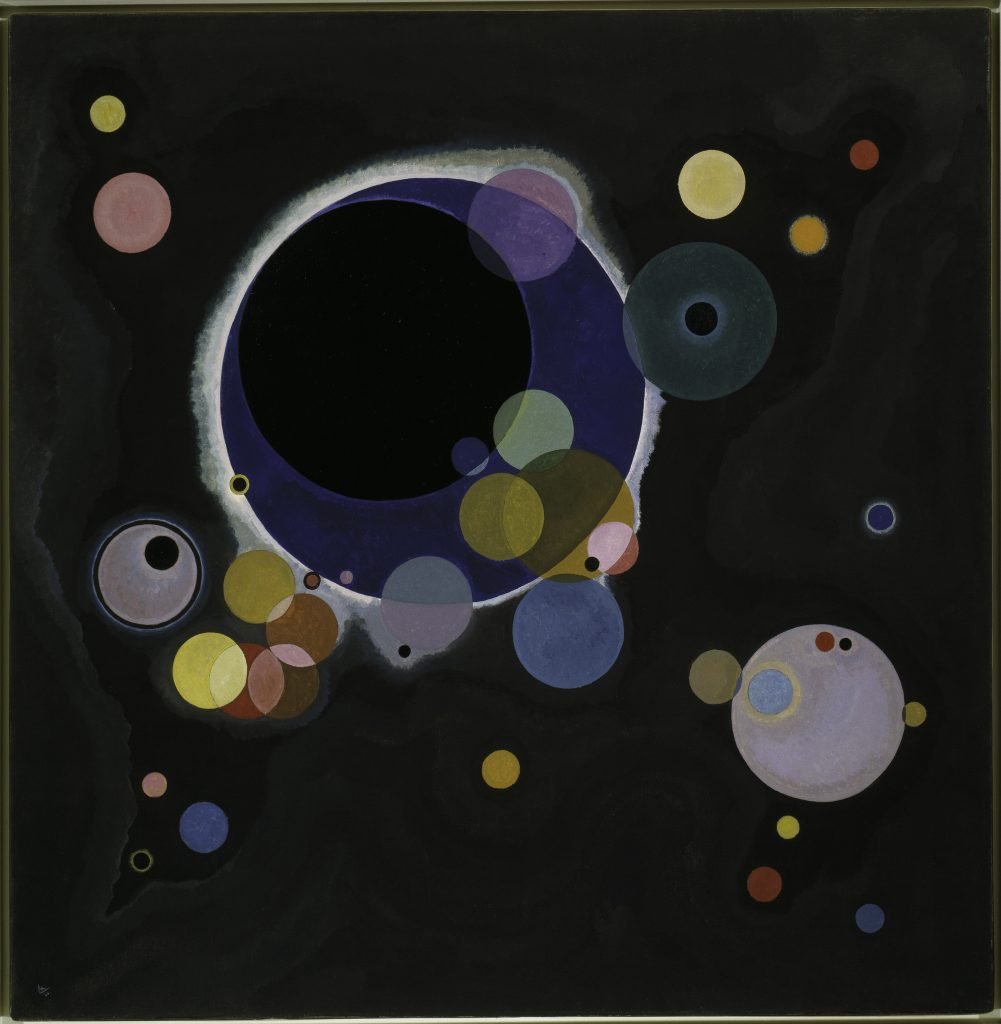
Vasily Kandinsky, Several Circles (1926), oil on canvas. Solomon R. Guggenheim Museum. © 2023 Artists Rights Society (ARS), New York.
Stepping into the doldrums of February, I decided to let an optimistic work by Vasily Kandinsky (1866–1944) guide my arrangement. Several Circles, a playful oil on canvas, was created when the Moscow-born painter and art theorist—part of the European modernist movement—was teaching at the Bauhaus in Germany. I saw it on view in Vasily Kandinsky: Around the Circle, a show at New York’s Solomon R. Guggenheim Museum. Kandinsky believed circles were a perfectly harmonious form and that each color not only activated a spiritual and emotional response but evoked a particular sound. The vivid rounds in this work, which overlap and dance on a black background, create an otherworldly effect and, if you stop to look and listen, a musical vibrancy.
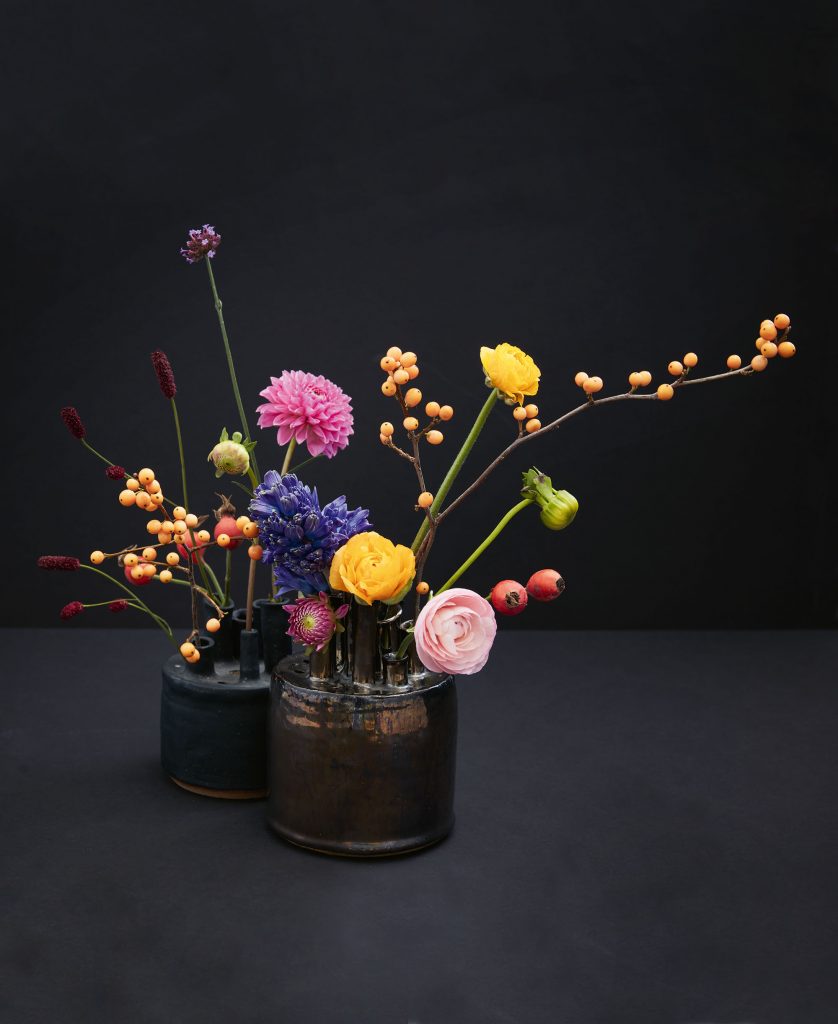
Burnet, dahlias, hyacinth, ranunculus, rose hips, verbena, and winterberry, arranged by Lindsey Taylor. From Art in Flower: Finding Inspiration in Art and Nature, published by Monacelli, a Phaidon company. Photo: Stephen Kent Johnson.
I started with two cylindrical vessels, one matte, the other glossy, by Cuban American ceramist Marité Acosta. Both sprout an array of tubular openings to hold individual stems. I nudged the vases together, themselves studies in circles, so they touched and appeared to be merging. A deep-blue hyacinth, cut short and beautifully bulbous, grounded the display as the largest circle in the painting does. Yellow and pink ranunculus lent their color and abundant disklike petals. Next came golden orbs of winterberry, pink dahlias both open and closed, rose hips, and wispy stems of verbena and burnet, all cut to various lengths so they visually cavorted with one another and filled in the negative space. The vases held the stems in place but also allowed them to burst out, creating a deconstructed arrangement like fireworks exploding in a night sky.